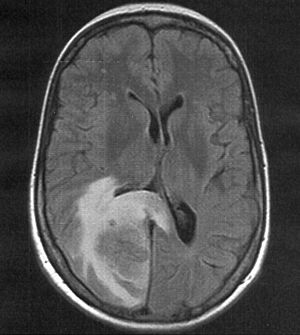Cerebral oedema facts for kids
Cerebral edema (say: suh-REE-brul uh-DEE-muh) is when too much fluid builds up inside your brain. This extra fluid causes the brain to swell. Think of it like a sprained ankle, but inside your head.
This swelling can happen because of a physical injury to the brain. It can also be caused by inflammation from some infections. Sometimes, mountain climbers get cerebral edema when they are very high up. This is because of the lower air pressure.
Cerebral edema can happen with many brain problems. These include strokes, serious head injuries, brain tumors, or brain infections. It can also be linked to very low salt levels in the blood or acute liver failure. Doctors find out if someone has cerebral edema by looking at their symptoms. They also use special scans like CT scans or MRI scans.
Treating cerebral edema depends on what caused it. Doctors might give medicines or manage fluids in the body. Sometimes, surgery is needed to help reduce the pressure. Cerebral edema is a serious problem. It can cause brain damage and is a big concern in cases of strokes and head injuries.
Contents
What are the signs and symptoms?
The signs of cerebral edema depend on how much fluid has built up. They are usually linked to an increase in pressure inside the skull. Your skull is a hard, fixed space. So, when extra fluid builds up, it can push on important brain tissue. It can also press on blood vessels and spinal fluid.
When the pressure inside the skull gets too high, it's a serious medical emergency. Signs of this include a bad headache, feeling sick (nausea), throwing up (vomiting), and becoming less aware. Sometimes, people might have problems with their vision or feel dizzy.
High pressure in the skull can also make your blood pressure go up. This is your body's way of trying to keep blood flowing to the brain. If this happens along with slow heart rate and unusual breathing, it's called the Cushing reflex. This reflex means the brain is being squeezed. This can reduce blood flow to the brain and can be very dangerous.
What causes cerebral edema?
Cerebral edema often happens after a brain injury. Here are some common causes:
- Serious head injuries
- Strokes
- Brain tumors
- Infections, like a brain abscess or meningitis
- Hepatic encephalopathy (a brain problem from severe liver disease)
- Posterior reversible encephalopathy syndrome (a brain disorder)
- Swelling caused by radiation treatment
- Changes after brain surgery
- Certain brain changes seen on scans
- Hyponatremia (very low sodium in the blood)
- High-altitude cerebral edema (swelling from being at very high altitudes)
Risk factors
Some things can make it more likely for someone to get cerebral edema. For example, in people who have had a stroke, these factors can increase the risk of early cerebral edema:
- Being younger
- Having more severe stroke symptoms
- Showing signs of brain damage on a medical exam
- Having a lower level of awareness
- Certain signs on CT scans
- Higher blood sugar levels
What happens next?
Cerebral edema is a serious problem that can happen after brain injuries. It is a major cause of brain damage. It also plays a big role in how well people recover from strokes and traumatic brain injuries.
For example, about 31% of people who have a certain type of stroke get brain swelling within 30 days. This swelling can make recovery harder. Even mild head injuries can lead to brain swelling. If swelling is seen on a scan right after a head injury, it can mean a higher risk of serious problems. Children with head injuries and brain swelling also tend to have more difficult recoveries.
See also
 In Spanish: Edema cerebral para niños
In Spanish: Edema cerebral para niños


